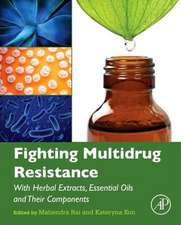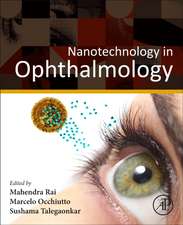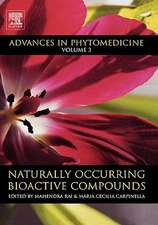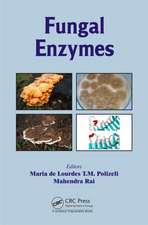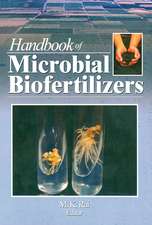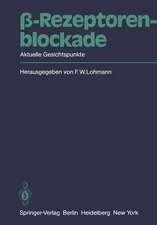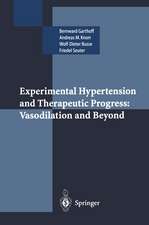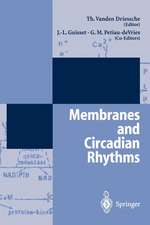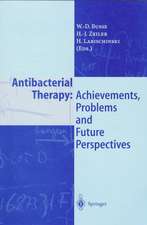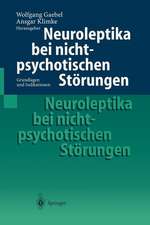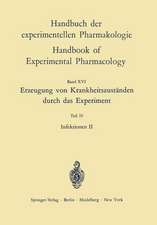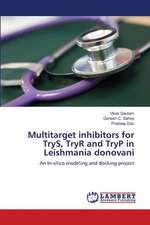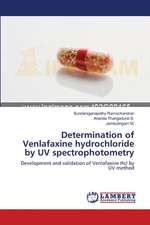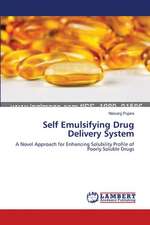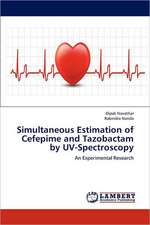Promising Antimicrobials from Natural Products
Editat de Mahendra Rai, Ivan Kosalecen Limba Engleză Hardback – 4 feb 2022
The book covers the results of the in vitro screening of antimicrobial activities of extracts and isolated compounds from natural origins. It is divided into three sections: i) Section I, includes natural antimicrobials from plants; ii) Section II incorporates antimicrobial agents/secondary metabolites from plants, and(iii) Section III focuses on antimicrobials from mushrooms, beehive and delivery systems for different types of antimicrobials.
Promising Antimicrobials From Natural Products is immensely useful for post graduate students, researchers in plant science, microbiology, biotechnology, pharmacology, pharma companies and those who are interested in herbal, eco-friendly, cost-effective and sustainable antimicrobials
| Toate formatele și edițiile | Preț | Express |
|---|---|---|
| Paperback (1) | 1103.58 lei 6-8 săpt. | |
| Springer International Publishing – 4 feb 2023 | 1103.58 lei 6-8 săpt. | |
| Hardback (1) | 1110.72 lei 6-8 săpt. | |
| Springer International Publishing – 4 feb 2022 | 1110.72 lei 6-8 săpt. |
Preț: 1110.72 lei
Preț vechi: 1169.19 lei
-5% Nou
Puncte Express: 1666
Preț estimativ în valută:
212.56€ • 230.81$ • 178.55£
212.56€ • 230.81$ • 178.55£
Carte tipărită la comandă
Livrare economică 22 aprilie-06 mai
Preluare comenzi: 021 569.72.76
Specificații
ISBN-13: 9783030835033
ISBN-10: 3030835030
Pagini: 451
Ilustrații: XIII, 451 p. 94 illus., 28 illus. in color.
Dimensiuni: 155 x 235 mm
Greutate: 0.83 kg
Ediția:1st ed. 2022
Editura: Springer International Publishing
Colecția Springer
Locul publicării:Cham, Switzerland
ISBN-10: 3030835030
Pagini: 451
Ilustrații: XIII, 451 p. 94 illus., 28 illus. in color.
Dimensiuni: 155 x 235 mm
Greutate: 0.83 kg
Ediția:1st ed. 2022
Editura: Springer International Publishing
Colecția Springer
Locul publicării:Cham, Switzerland
Cuprins
Section I: General, Identity and Taxonomy.- The genus Phoma: What we know and what we need to know?.- Taxonomical evaluation of Phoma- history of classification, current status and future directions.- Section II: Diversity, Diseases and Host Range.- Phoma on medicinal and aromatic plants.- Diseases of fruits, tubers, and seeds caused by Phoma sensu lato species complex.- Overview of Phoma-like fungi on important legumes (Papilionaceous plants).- Diseases of vegetables caused by Phoma spp.- Phoma diseases: identification, epidemiology and strategies for management.- Major plant diseases caused by Phoma sensu lato species and their integrated management strategies.- Phoma as an infectious pathogen in medical practice.- Section III: Secondary metabolites and Bioactivities.- Fruitful decade of Phoma secondary metabolites from 2011 to 2020: Chemistry, chemical diversity and biological activities.- Bioactive secondary metabolites from endophytic Phoma spp.- The genus Phoma: a review of its potential bioactivities, implications and prospects.- Bioherbicidal activity of Phoma macrostoma.- New technologies for the formulation of secondary metabolites produced by Phoma sp. for biological control of weeds.- Biological management of plant diseases by non-pathogenic Phoma spp.- Plant growth promoting Phoma spp.- Section IV:Nanotechnology and Fossil records of Phoma.- Potential role of Phoma spp. for mycogenic synthesis of Silver nanoparticles.- In situ occurrence of Phomites Fritel in the phyllosphere of ancient Siwalik forests of eastern Himalaya during the Mio-Pleistocene.
Notă biografică
Professor Mahendra Rai is a Basic Science Research Faculty Fellow at Department of Biotechnology, Sant Gadge Baba Amravati University in Maharashtra, India. He has published more than 400 research publications, 100 popular articles in journals of high repute and 60 books from reputed publishers. He has received several prestigious awards, including the father T.A. Mathias award from the All-India Association for Christian Higher Education, and the Medini award from the Department of Environment and Forest, Government of India. He also received SERC visiting fellowship by Department of Science and Technology , INSA visiting fellowship by Indian National Science Academy and TWAS-UNESCO Associateship , Italy. Dr. Rai serves as a referee for more than 20 international journals and is associate editor/ member of editorial board of more than ten national and international journals. He has approximately three decades of teaching and research experience. The main focus of his research is nanobiotechnology and nano based bioactive against human pathogenic microbes.
Ivan Kosalec, a tenured scientific advisor, holds a professorship at the University of Zagreb, Faculty of Pharmacy and Biochemistry. Since Croatia's accession to the EU (2013), he has served as a Croatian delegate to the European Medicines Agency (EMA) in the HMPC Committee. He is also an external expert for the Croatian Medicines and Medical Devices Agency and a member of the interdisciplinary section of the Ministry of Health for Antibiotic Resistance Control (ISKRA). The main focus of his scientific work is in the field of virulence inhibition of medically important yeasts and determination of in vitro antimicrobial activity of compounds of synthetic and natural origin. He has published more than 100 scientific papers in peer-reviewed journals. Dr Ivan Kosalec has participated in several European and national projects mainly dealing with the identification of microbial species and the antimicrobial activity of substances of different origins (nanomaterials, botanicals, de novo synthesised molecules, etc.). As an active referee, he is also a member of the international editorial board in three scientific journals (Molecules, Archives of Occupational Hygiene and Toxicology). Dr I. Kosalec received the Diploma - Distinction from Croatian Pharmaceutical Society in 2017.
Ivan Kosalec, a tenured scientific advisor, holds a professorship at the University of Zagreb, Faculty of Pharmacy and Biochemistry. Since Croatia's accession to the EU (2013), he has served as a Croatian delegate to the European Medicines Agency (EMA) in the HMPC Committee. He is also an external expert for the Croatian Medicines and Medical Devices Agency and a member of the interdisciplinary section of the Ministry of Health for Antibiotic Resistance Control (ISKRA). The main focus of his scientific work is in the field of virulence inhibition of medically important yeasts and determination of in vitro antimicrobial activity of compounds of synthetic and natural origin. He has published more than 100 scientific papers in peer-reviewed journals. Dr Ivan Kosalec has participated in several European and national projects mainly dealing with the identification of microbial species and the antimicrobial activity of substances of different origins (nanomaterials, botanicals, de novo synthesised molecules, etc.). As an active referee, he is also a member of the international editorial board in three scientific journals (Molecules, Archives of Occupational Hygiene and Toxicology). Dr I. Kosalec received the Diploma - Distinction from Croatian Pharmaceutical Society in 2017.
Textul de pe ultima copertă
Given novel infectious diseases such as COVID-19 and antibiotic resistance new antimicrobial discovery is an important research area. Considering that nature is a vast source of bioactive molecules with antimicrobial activity, the main aim of this book is to present a comprehensive outlook of current research in the field of natural antimicrobials. It discusses the antimicrobial activity of medicinal plants, beehives, and mushrooms with a global coverage of antimicrobial agents from rich forests of Brazil (Amazon), North-Eastern forests of Peru, Argentina, Colombia, India, Bangladesh, Nepal, Middle East, Turkey, Croatia, Greece, Germany and Russia.
The book covers the results of the in vitro screening of antimicrobial activities of extracts and isolated compounds from natural origins. It is divided into three sections: i) Section I, includes natural antimicrobials from plants; ii) Section II incorporates antimicrobial agents/secondary metabolites from plants, and (iii) Section III focuses on antimicrobials from mushrooms, beehive and delivery systems for different types of antimicrobials.
Promising Antimicrobials From Natural Products is immensely useful for post graduate students, researchers in plant science, microbiology, biotechnology, pharmacology, pharma companies and those who are interested in herbal, eco-friendly, cost-effective and sustainable antimicrobials.
The book covers the results of the in vitro screening of antimicrobial activities of extracts and isolated compounds from natural origins. It is divided into three sections: i) Section I, includes natural antimicrobials from plants; ii) Section II incorporates antimicrobial agents/secondary metabolites from plants, and (iii) Section III focuses on antimicrobials from mushrooms, beehive and delivery systems for different types of antimicrobials.
Promising Antimicrobials From Natural Products is immensely useful for post graduate students, researchers in plant science, microbiology, biotechnology, pharmacology, pharma companies and those who are interested in herbal, eco-friendly, cost-effective and sustainable antimicrobials.
- Contains results of in vitro screening of extracts and isolated compounds
- Focuses on delivery systems
- Covers antimicrobial medicinal plants of Brazil (Amazon), North-Eastern forests of Peru, Argentina, Colombia, India, Bangladesh, Nepal, Middle East, Turkey, Croatia, Greece, Germany and Russia.
Caracteristici
Presents in vitro screening of extracts and isolated compounds Focuses on delivery systems Covers antimicrobial medicinal plants of South America, Europe, and Asia

